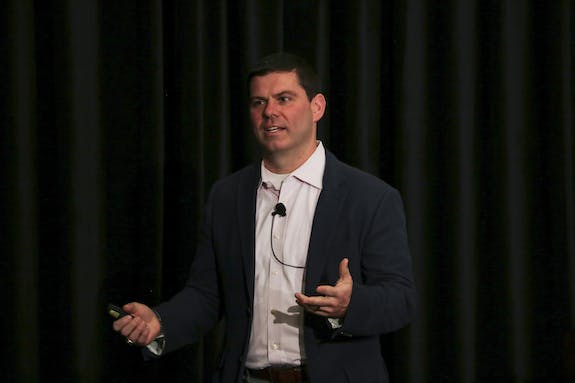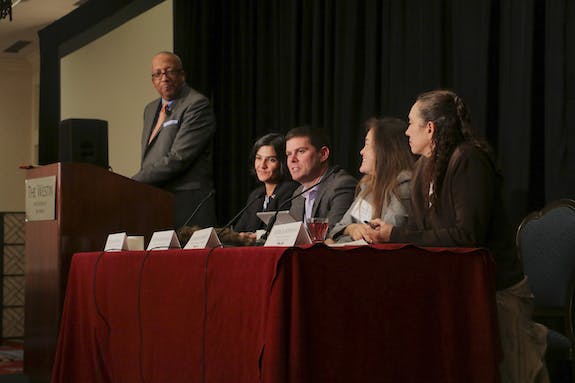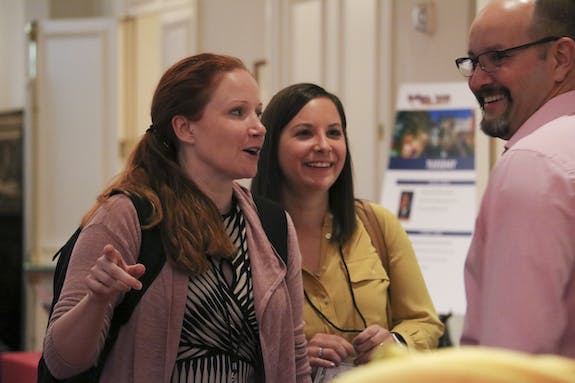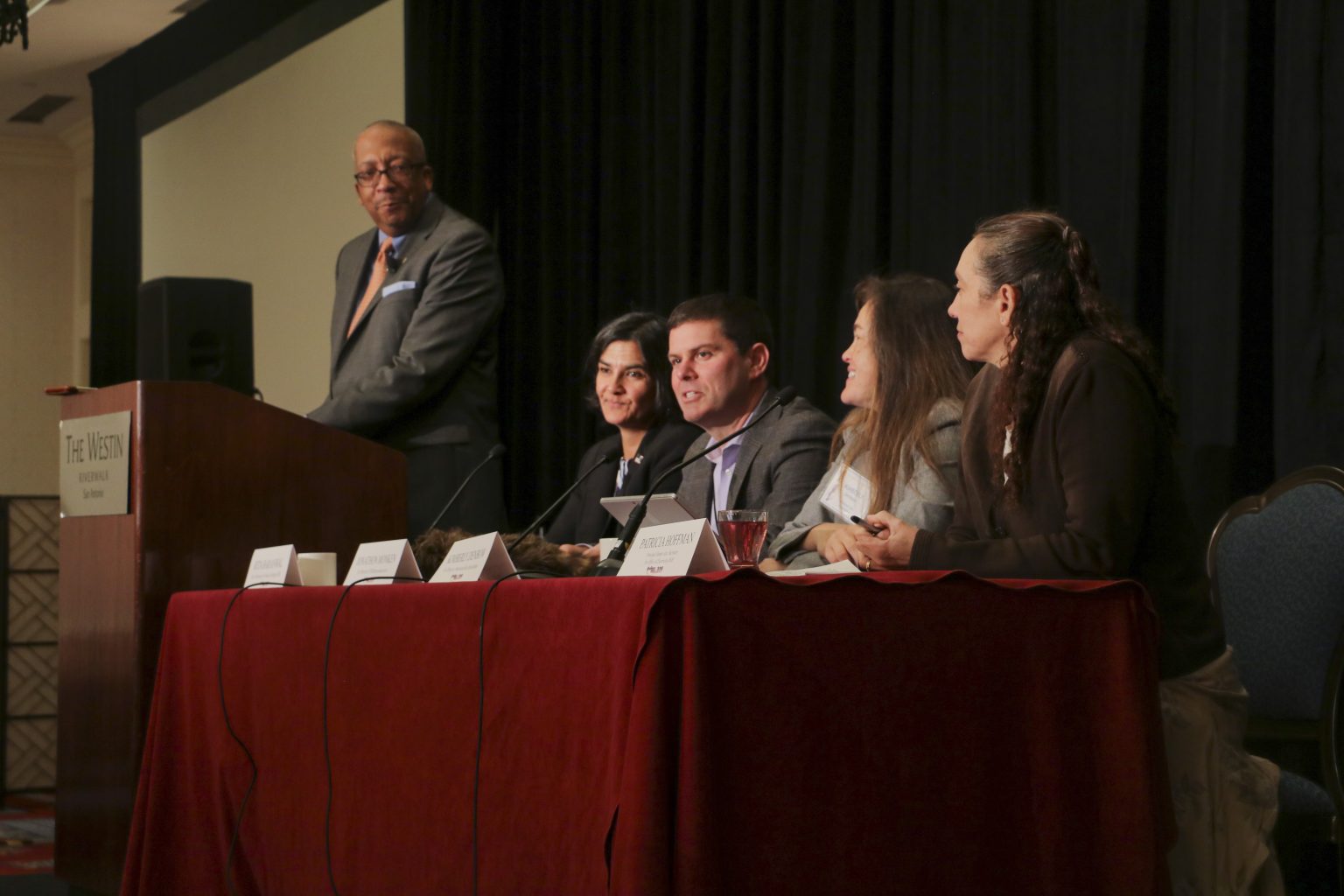Seated in the ballroom of the Westin Riverwalk Hotel in downtown San Antonio, a crowd of 300 people eagerly awaited the start of Idaho National Laboratory’s Resilience Week 2019 Symposium. On a humid Tuesday morning in early November, attendees from across academia, industry and government gathered in Texas to present their latest research, collaborate with colleagues and explore new ideas to secure the nation’s critical infrastructure systems from an increasing array of physical and cyberthreats.
As Texas Rep. Joaquin Castro stepped to the stage to address the crowd, it was apparent the event was going to be bigger and more technically diverse than any previous Resilience Week Symposium since the laboratory began hosting them in 2007. Castro, a second-generation Mexican-American, grew up in San Antonio before attending Stanford and Harvard Law School. He returned to the Lone Star State after college, eventually serving five terms in the state legislature before serving in the U.S. House of Representatives. In Congress, he’s been a strong advocate for passing legislation to enhance cybersecurity response.
“Cybersecurity is a national and international topic of concern, but it’s also a local issue,” said Castro. “Last August, 23 cities in Texas were victims of a coordinated ransomware attack. Events like these are why the National Cybersecurity Preparedness Consortium Act that I’ve been working on needs to be passed and signed by the president. It would provide local governments with more resources to deal with cybersecurity.”

Castro believes fostering more collaboration between the government and private sector is one way states and cities can become more secure in increasingly uncertain times. His remarks struck just the right tone with the audience as the symposium kicked off. His words demonstrated how policymakers are reaching out to the research community to help inform a tangible path forward for resilient infrastructure. It was also indicative of how large, complex problems – like protecting critical infrastructure systems – require the knowledge and collaboration of many kinds of people with different viewpoints and experiences.
For five full days, experts debated resiliency challenges and solutions while participating in nearly 50 technical sessions. From plenary sessions to panel discussions, topics ranged from advanced sensors and analytics to enhance the electric grid, to threat information sharing and wireless 5G security for critical infrastructures. And at every juncture, there was an impressive depth of talent on stage. From university faculty from Idaho, Maryland, Texas and Virginia, to industry leaders like the Edison Electric Institute and Dominion Energy and even representatives from nine national labs. The diverse mix of talent on stage was an indication of how the resiliency field is becoming more inclusive, and how broad the challenges are of strengthening the nation’s critical infrastructures.
“Resilience is not a one-size-fits-all approach; it really takes a combination of many different elements all contributing to it,” said Jonathon Monken, senior director of system resiliency and strategic coordination for PJM Interconnection. “What I love about this setup is you get an opportunity to put researchers and technologists in the same room as the practitioners and operators. And that’s really the secret sauce to success in resiliency, making sure the link between these groups is well-established and the lines of communication are open.”

In the past, resiliency has been a seemingly abstract term. But recent events, from hurricanes to wildfires and cyberattacks, have solidified the areas that need improvements, while spurring frank conversations and new research ideas. Today, most experts understand resiliency to mean the ability to withstand adverse events, and if not, then to quickly restore conditions to a state of normalcy following a crisis. From an infrastructure perspective, resiliency is about strengthening important assets like the electric power grid to withstand weather-related natural disaster. It explores ways to enhance the security of digital control systems from advanced cyberthreats. And it looks outward suggesting how future technology may impact the production of food and water, the ability to manufacture consumer goods and deliver health care and transportation services to mass populations in a safe and secure manner.
“Resilience Week is a terrific event because it allows us to focus on the outlier events that we don’t expect to occur but that we need to be ready for just in case,” said Dr. Brian Kelley, an associate professor and assistant-associate dean fellow at the University of Texas San Antonio. “My work focuses on advanced technology, embedded sensors and communication systems and how these things are increasingly part of our critical infrastructures, and in many cases are making infrastructure become more critical through interdependencies.”
As attendees shuffled throughout the convention hall, there were ample opportunities for formal and informal conversations to occur on a range of topics. Discussions ranged from the Department of Homeland Security’s Regional Resiliency Assessment Program to industry panels on leveraging partnerships across the energy sector to collaborative engagements about building the cybersecurity workforce of the future. There were conversations on cyber-physical resilience, security implications for the integration of renewable energy into the grid and a Defense Department led session on best practices for recovering from disasters. Altogether, a strong synergy and commonality emerged among attendees entirely focused on critical infrastructure protection.

During one plenary panel, Zach Tudor, INL’s associate laboratory director for National and Homeland Security, led a discussion on building resiliency into the grid of the future. On the panel providing expert analysis were PJM’s Monken, Rita Baranwal, assistance secretary for the Department of Energy’s Office of Nuclear Energy, Pat Hoffman, principal deputy assistant secretary for the DOE Office of Electricity, and Kimberly Denbow, managing director of security and operations at the American Gas Association.
As a first-time Resilience Week attendee and a keynote speaker, Denbow told the audience that the complexities of infrastructure resiliency require technical knowledge, but just as important are the soft skills of human interaction.
“I’ve been very impressed with the quality of the presentations and the conversations that I’ve had with people at Resilience Week,” said Denbow. “The collaboration, the communication and the forging of relationships at events like this really helps advance solutions and build the trust that is so important during a time of crisis.”
And for Denbow, collaboration often means working however and with whomever can solve problems in the quickest manner possible.
“We’ve put in place mutual assistance programs at hundreds of utilities around the country that involve cross-training and knowledge transfer approaches to security,” said Denbow. “Because based on our history of dealing with natural disasters, the average time to completely restore services after a major event is still around six months.”

And while that time frame is better than just a few years ago, Denbow hopes breaking down barriers and opening lines of communication will lead to further improvements. As she noted, “the big, bad infrastructure challenges we face aren’t going away anytime soon.
“Particularly when it comes to cybersecurity, the need is so great that we don’t even try to compete with other utilities in our service area; we simply collaborate,” said Denbow.
As Resilience Week 2019 came to its close, the convention hall was filled with busy chatter. New friendships were formed, business cards and ideas were exchanged and promises to explore new research were cemented. At the same time, attendees had a pragmatic realization that much work remains to be done to secure the nation’s most important assets from the difficult challenges that lie ahead.
“Right now, there’s still too much of a gap in the critical infrastructure community between the engineering side and the policy side,” said Monken. “But interactions like we have at Resilience Week help bridge that space and create outcomes where policy goals can be achieved using engineering-driven outcomes.”
In October, INL will host Resilience Week 2020 in Salt Lake City in collaboration with the University of Utah. The call for papers and presentations is open until April 22.







